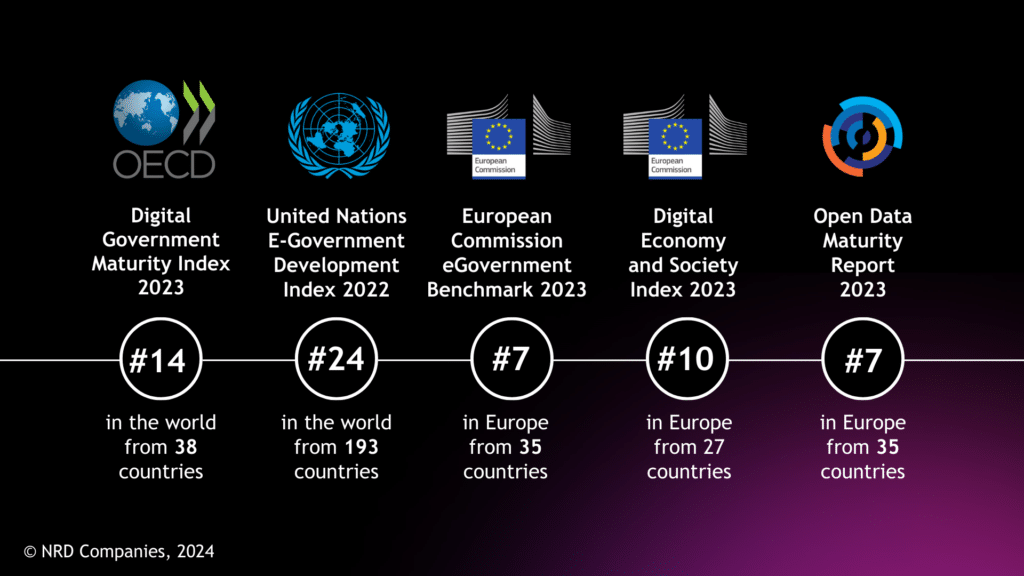Ready to take the next step towards digital transformation?
Fill out the form and one of our experts will get in touch with you shortly.


Thank you!
We will contact you soon!
More than 30 years ago, in November 1991, Lithuania published its first state digitization vision, “Lithuania 2000”, marking the inception of its journey towards digital transformation. This initiative sought the collaboration of leading IT firms to bolster Lithuania’s information infrastructure, aiming to forge a brighter future for its citizens through technology.
Advancements and Achievements
A decade later, in the early 2000s, the country declared the development of the “information society” as its high-level political goal. The concept of an information society became a cornerstone of the official program of the newly elected government; a dedicated coordinating institution was established; detailed strategies and roadmaps were defined. These plans were supported by the European Union Structural Funds for Lithuania, as significant investments were necessary to establish the digital foundations of a young nation. These investments were concentrated on building three pillars of the “information society” concept: digital public services, digital access and skills, and digital infrastructure – all interdependent and crucial for overall success.
These efforts were not in vain. Today, Lithuania has a solid digital foundation, as witnessed by its high rankings in global indexes.
Recent Wins and Achievements
- At the beginning of 2024, the first-ever Digital Government Maturity Index by the Organization for Economic Cooperation and Development (OECD) ranked Lithuania 14th among the 38 most advanced countries in the world, all members of the OECD.
- Lithuania surged from 39th to 34th place in the World Innovation Index and from 26th to 23rd place in the world IMD Talent ranking.
- According to the 2023 European Union Digital Economy and Society Index (DESI), Lithuania ranks 10th in how well digital services work for citizens, and 6th for businesses. It’s also the 2nd best in the EU for using pre-filled forms with digital services.
- In the European Commission’s E-Government Benchmark for 2023, Lithuania came in 7th place. Users of public services praised how easy it is to use eID and pre-filled forms to get things done.
- The 2022 E-Government Development Index by the United Nations demonstrated Lithuania’s impressive leap from 43rd to 24th place within 20 years.
- The 2023 Open Data Maturity Report ranked Lithuania in 7th place among 35 European countries. Also, in the OECD “OURdata Index,” Lithuania is now the 10th best out of all OECD countries for its open government data policies.
- In Europe, Lithuania is the 2nd best in the ability of its people to access their e-health records, according to DESI 2023.
- As of 2023, a commendable 72% of Lithuania’s population actively engages with public digital services.

From Struggle to Success: Digitalizing Public Services
Looking back to 2003, less than half of key public services were online and only a third of state and municipal institutions offered online services, showing how far Lithuania has come. At that time, only about a quarter of internet users, which was just 6% of the total population, had used government websites.
This was the starting point for the development of the internet portal “Electronic Government Gateway” (www.epaslaugos.lt) . The project kicked off in 2003, and by the end of 2004, over 700 e-government services were accessible through the electronic government portal’s catalog. In the years that followed, the “Electronic Government Gateway” was continuously expanded to keep pace with advancing technological capabilities and business needs. To ensure the seamless operation of the “one-stop shop” approach, a data exchange platform was established, along with accompanying legislation, guidelines, and protocols, enabling the data exchange between information systems of institutions operating in various technological environments.
Following decade witnessed fast development of key digital services in various domains: social protection and health care, business and commerce, education and family, judiciary and migration, to name just a few. Sometimes by different speeds, but more and more institutions recognized the strategic importance of their “digital presence”, and dedicated efforts to develop digital services that would be user-centric and data-driven. The requirements, methodologies, and methodological support on how to build advanced digital public services was provided to the institutions, to ensure that the resulting digital services would respond to the needs of their users.
Investments in Infrastructure and Skills
Now, in 2024, most public services are available online. The digital level of key public services for citizens reached 84%, and for businesses – 94% (EU average being respectively 77% and 84%).
In parallel to launching and improving digital services, Lithuania dedicated significant attention to other two pillars of the country’s digital transformation: digital infrastructure and digital skills. Digital infrastructure provides the essential technological backbone and connectivity necessary for digital services and skills to thrive. In Lithuania, the most significant initiative in this regard was the multi-annual project Rural Area Information Technology Network (RAIN), aimed at bridging the digital divide and ensuring internet connectivity in remote rural areas. Lithuania was one of the first EU countries to pioneer such public investments, earning the RAIN project a spot among the 12 exemplary projects of good practice featured in The Guide to Broadband Investment by the European Commission. As for the digital skills, their development in population is being supported by various initiatives: from providing digital competences trainings through the extensive public internet access network established in 1200 public libraries, to implementing national initiatives such as “Lithuania connected”, which involved 700 local communities, 1,500 e-scouts, and 2,000 digital consultants, and reached over 500,000 citizens, representing a remarkable 20% of Lithuania’s population.
A Vision for the Future: Innovation, Transparency, and Citizen-Centric Governance
Even with all these achievements, there’s still a lot to do. By sharing experiences and lessons learned, Lithuania seeks to inspire and guide nations on their digital transformation journey. And these lessons can be applied not only to other countries but also to Lithuania itself, as a reminder of what has been tried and led to success.
Want to learn more about digitalization?
Contact us to discuss any inquiries you might have about this topic.


Thank you!
We will contact you soon!
About the Author
Ieva Žilionienė dedicated 15 years of her professional career to building Lithuania’s digital foundations. She was a key member of the original team that established and nurtured the Information Society Development Committee, the agency responsible for coordinating Lithuania’s digital transformation. Currently, she leads the consultancy division at NRD Companies, an international compant that supports governments and institutions worldwide in their digital development endeavors.













